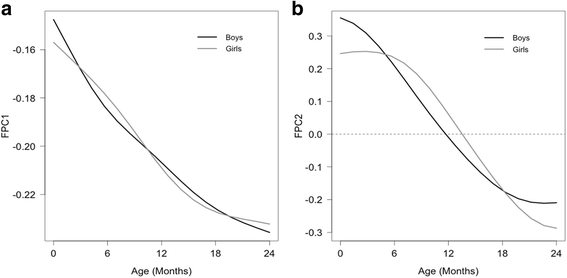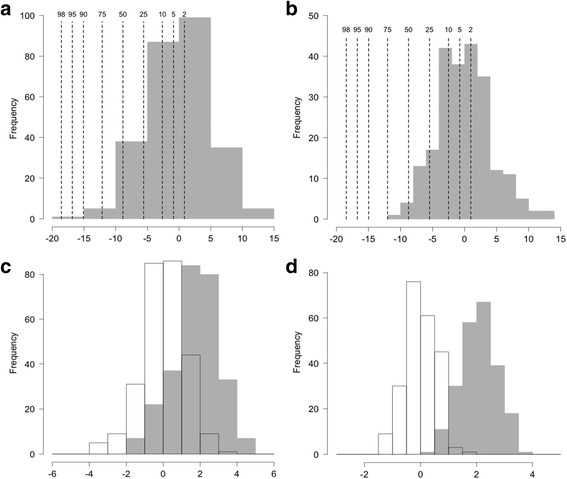Characterizing early child growth patterns of height-for-age in an urban slum cohort of Bangladesh with functional principal component analysis
- PMID: 28327104
- PMCID: PMC5359797
- DOI: 10.1186/s12887-017-0831-y
Characterizing early child growth patterns of height-for-age in an urban slum cohort of Bangladesh with functional principal component analysis
Abstract
Background: Early childhood is a critical stage of physical and cognitive growth that forms the foundation of future wellbeing. Stunted growth is presented in one of every 4 children worldwide and contributes to developmental impairment and under-five mortality. Better understanding of early growth patterns should allow for early detection and intervention in malnutrition. We aimed to characterize early child growth patterns and quantify the change of growth curves from the World Health Organization (WHO) Child Growth Standards.
Methods: In a cohort of 626 Bangladesh children, longitudinal height-for-age z-scores (HAZ) were modelled over the first 24 months of life using functional principal component analysis (FPCA). Deviation of individual growth from the WHO standards was quantified based on the leading functional principal components (FPCs), and growth faltering was detected as it occurred. The risk factors associated with growth faltering were identified in a linear regression.
Results: Ninety-eight percent of temporal variation in growth trajectories over the first 24 months of life was captured by two leading FPCs (FPC1 for overall growth and FPC2 for change in growth trajectory). A derived index, adj-FPC2, quantified the change in growth trajectory (i.e., growth faltering) relative to the WHO standards. In addition to HAZ at birth, significant risk factors associated with growth faltering in boys included duration of breastfeeding, family size and income and in girls maternal weight and water source.
Conclusions: The underlying growth patterns of HAZ in the first 2 years of life were delineated with FPCA, and the deviations from the WHO standards were quantified from the two leading FPCs. The adj-FPC2 score provided a meaningful measure of growth faltering in the first 2 years of life, which enabled us to identify the risk factors associated with poor growth that would have otherwise been missed. Understanding faltering patterns and associated risk factors are important in the development of effective intervention strategies to improve childhood growth globally.
Trial registration: ClinicalTrials.gov Identifier: NCT02734264 , registered 22 March, 2016.
Keywords: Anthropometry; Functional data analysis; Growth faltering; Longitudinal growth; Stunting.
Figures




Similar articles
-
Pattern of growth faltering and recovery in under 5 children in India using WHO growth standards--a study on First and Third National Family Health Survey.Indian Pediatr. 2011 Nov 11;48(11):855-60. doi: 10.1007/s13312-011-0139-1. Epub 2011 Mar 15. Indian Pediatr. 2011. PMID: 21555805
-
Early childhood linear growth faltering in low-income and middle-income countries as a whole-population condition: analysis of 179 Demographic and Health Surveys from 64 countries (1993-2015).Lancet Glob Health. 2017 Dec;5(12):e1249-e1257. doi: 10.1016/S2214-109X(17)30418-7. Lancet Glob Health. 2017. PMID: 29132614 Free PMC article.
-
[WHO growth standards for infants and young children].Arch Pediatr. 2009 Jan;16(1):47-53. doi: 10.1016/j.arcped.2008.10.010. Epub 2008 Nov 25. Arch Pediatr. 2009. PMID: 19036567 Review. French.
-
Growth faltering is associated with altered brain functional connectivity and cognitive outcomes in urban Bangladeshi children exposed to early adversity.BMC Med. 2019 Nov 25;17(1):199. doi: 10.1186/s12916-019-1431-5. BMC Med. 2019. PMID: 31760950 Free PMC article.
-
Practical Application of Linear Growth Measurements in Clinical Research in Low- and Middle-Income Countries.Horm Res Paediatr. 2017;88(1):79-90. doi: 10.1159/000456007. Epub 2017 Feb 14. Horm Res Paediatr. 2017. PMID: 28196362 Free PMC article. Review.
Cited by
-
Growth dynamics of Indian infants using latent trajectory models in pooled survey datasets.Front Public Health. 2025 Jan 7;12:1474222. doi: 10.3389/fpubh.2024.1474222. eCollection 2024. Front Public Health. 2025. PMID: 39839386 Free PMC article.
-
Scalar-on-function regression for predicting distal outcomes from intensively gathered longitudinal data: Interpretability for applied scientists.Stat Surv. 2019;13:150-180. doi: 10.1214/19-SS126. Epub 2019 Nov 6. Stat Surv. 2019. PMID: 31745402 Free PMC article.
-
Derivation and external validation of clinical prediction rules identifying children at risk of linear growth faltering.Elife. 2023 Jan 6;12:e78491. doi: 10.7554/eLife.78491. Elife. 2023. PMID: 36607225 Free PMC article.
-
Mucosal Genomics Implicate Lymphocyte Activation and Lipid Metabolism in Refractory Environmental Enteric Dysfunction.Gastroenterology. 2021 May;160(6):2055-2071.e0. doi: 10.1053/j.gastro.2021.01.221. Epub 2021 Jan 29. Gastroenterology. 2021. PMID: 33524399 Free PMC article.
-
Early childhood growth in Daasanach pastoralists of Northern Kenya: Distinct patterns of faltering in linear growth and weight gain.Am J Hum Biol. 2023 Apr;35(4):e23842. doi: 10.1002/ajhb.23842. Epub 2022 Dec 3. Am J Hum Biol. 2023. PMID: 36463096 Free PMC article.
References
-
- WHO Multicentre Growth Reference Study Group . WHO Child Growth Standards: Length/height-for-age, weight-for-age, weight-for-length, weight-for-height and body mass index-for-age: Methods and development. Geneva: World Health Organization; 2006.
-
- Black RE, Allen LH, Bhutta ZA, Caulfield LE, de Onis M, Ezzati M, Mathers C, Rivera J, Maternal and Child Undernutrition Study Group Maternal and child undernutrition: global and regional exposures and health consequences. Lancet. 2008;371(9608):243–260. doi: 10.1016/S0140-6736(07)61690-0. - DOI - PubMed
Publication types
MeSH terms
Associated data
Grants and funding
LinkOut - more resources
Full Text Sources
Other Literature Sources
Medical

